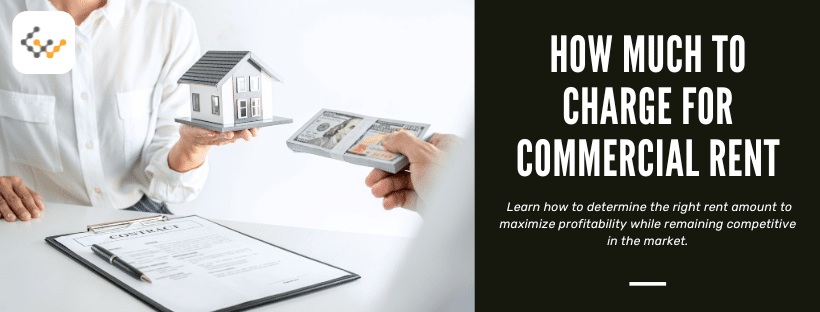How Much to Charge for Commercial Rent: 5 Key Considerations

Commercial real estate investors must accurately determine how much rent they should charge. Too high rent will result in tenant turnover and vacancies, and too low rent will result in lower returns and potential cash flow issues. The right rent will be competitive with the local market and also provide a satisfactory return on investment (ROI). Here are some ways to determine how much to charge for commercial rent.
What Factors Influence Commercial Rent?
Commercial rents are affected by many factors, and they can vary quite significantly. Some of the factors that commercial landlords often consider when setting rents include:
- Location and Comps: Location is always one of the driving factors of rent rates. The rents that highly desirable locations command can be much higher than those in less desirable areas. Comps can be used to determine a potential range based on the local market.
- Type of Building: Retail spaces, office buildings, industrial facilities, warehouses, medical buildings, and others command different rents. These properties attract tenants with different budgets and needs. Mixed-use properties
will even have different rent rates for their various types of spaces. - Size and Layout: Large properties tend to command higher rents than smaller properties, although there can be exceptions. Sometimes configurations can have a minor influence if parking, visibility, storage space, or other additional features are important to tenants.
- Operating Expenses and Improvements: For most properties, collected rent should at least pay all operating expenses and cover any capital improvements.
- Season: The time of year can significantly affect rent rates for smaller retail spaces, as small and seasonal retailers will increase demand around the holidays. Seasonality can also sometimes impact rents for multifamily properties, such as those in college towns.
The type of lease can also have a significant impact on rents. The more services a landlord provides, the more the tenant typically pays. A full-service lease, where the landlord is responsible for taxes, insurance, maintenance, repairs, and other expenses, will usually command the highest rent. A triple net lease and
absolute net lease will each, respectively, call for lower rents as tenants assume more responsibilities (and risk).
All of these factors should be analyzed when evaluating a potential property, and also when negotiating rents with renewing or new tenants.
What Rent Structures Are There?
Commercial landlords might use a few different ways to structure tenants’ rents. The most common is basing rent on square footage, but there are other options.
Square Footage
Square footage is favored partly because it’s the most straightforward way to structure a lease. Tenants simply pay a flat rate per square foot. The amount is negotiated, but there are no additional steps after the rate and total payment is calculated.
In most cases, square footage leases are based on an annual rate. The negotiated rate is then multiplied by the total square footage and then divided by 12 for a monthly payment.
For example, a tenant might pay $15/sq. ft. per year. If the tenant leases 5,000 square feet, then their annual rent would be $75.000, and the monthly payment would be $6,250.
Sometimes seasonal businesses or new businesses might want a short-term lease. A tax service may want a 4-month lease at the start of the year, or a new retailer may request a 2-month lease during the holidays. These leases can still be based on square footage. The negotiated rate per square foot simply needs to be on a monthly rather than annual basis.
Alternative Rent Structures
In certain situations, alternative commercial rent structures might be a better option for both landlord and tenant. Some other ways of structuring rent are:
- Percentage Rent: Often used in retail leases, where tenants pay a
Base rent plus a percentage of their monthly sales. The additional amount is frequently any sales above a certain threshold. A percentage structure aligns the landlord’s interests with the tenant’s success. - Gross Rent: Tenants pay a flat rate that covers rent and all or most property-related expenses (taxes, insurance, maintenance). This can simplify budgeting for tenants but may result in higher overall costs.
- Net Rent: Also known as “triple net” (NNN), this structure has tenants pay base rent plus property expenses
(taxes, insurance, and maintenance), offering more predictability for landlords. - Variable Rent: Some agreements include provisions for rent adjustments based on inflation, market changes, or predetermined schedules, offering flexibility to both parties.
How Much to Charge for Commercial Rent
Determining the right price involves balancing market demand with your need to cover expenses and earn a positive return. The process should include running comparables, evaluating your property’s unique features, assessing market trends, and possibly consulting an experienced commercial real estate agent in the area,
Strategies for Setting Your Rent
Several strategies can help you through this process, hopefully converging on a range that makes sense for the market and for your property.
- Market Analysis: Conduct a thorough market analysis to understand the demand for commercial spaces like yours and the average rent rates in your location. This research should include not just current rates but also trends in the market.
- Evaluate Your Costs: Calculate your total costs, including mortgage, taxes, insurance, maintenance, and any services you offer. Your rent usually should cover these costs while providing a reasonable return on investment.
- Consider Tenant Improvements: If you’re willing to invest in tenant improvements (TIs), you might be able to charge higher rent. These investments can make your property more appealing and justify a higher rate.
- Flexibility: Be open to negotiating terms and rent structures to attract and retain tenants. Offering incentives like reduced rent for a longer lease term can secure a tenant and ensure a steady income.
- Review Regularly: The commercial real estate market can change. Regularly review and adjust your rents and terms to stay competitive and maximize your returns.
Wrapping Up
Setting the right rent for your commercial property is a balance of art and science, requiring a deep understanding of the market, your property, and the needs of potential tenants. Use these structures and strategies to determine how much you should charge tenants for space in your commercial property.

